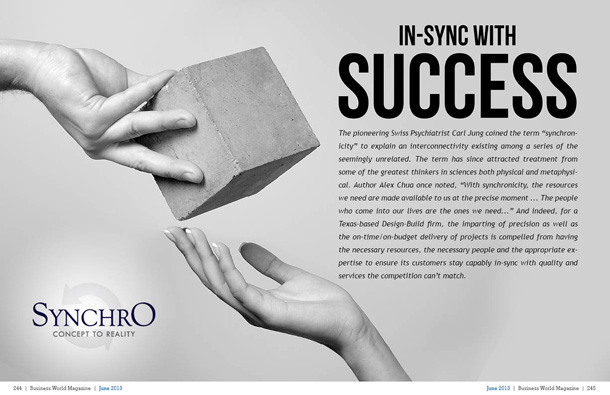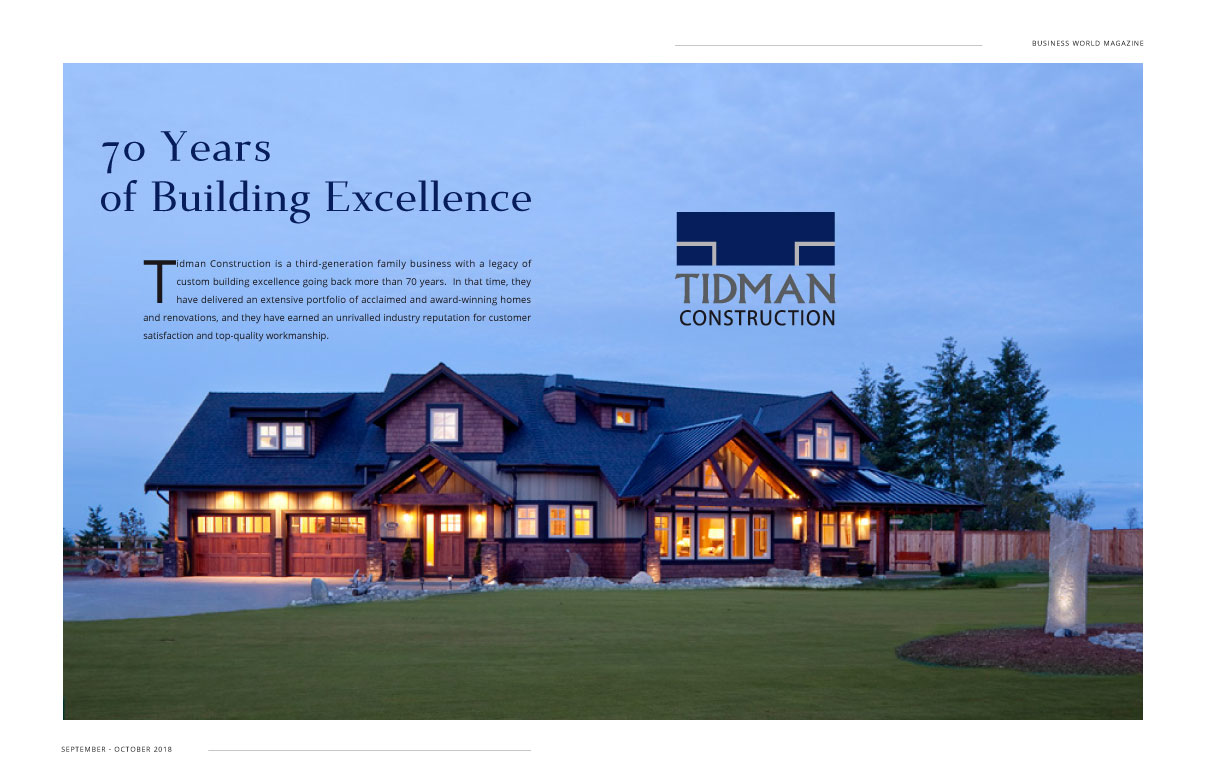
In-Sync with Success

The pioneering Swiss Psychiatrist Carl Jung coined the term “synchronicity†to explain an interconnectivity existing among a series of the seemingly unrelated. The term has since attracted treatment from some of the greatest thinkers in sciences both physical and metaphysical. Author Alex Chua once noted, “With synchronicity, the resources we need are made available to us at the precise moment … The people who come into our lives are the ones we need…†And indeed, for a Texas-based Design-Build firm, the imparting of precision as well as the on-time/on-budget delivery of projects is compelled from having the necessary resources, the necessary people and the appropriate expertise to ensure its customers stay capably in-sync with quality and services the competition can’t match.
For more than fifty years, Houston’s Synchro Building Corporation has been a leader in the design build construction field by offering in-house architectural and complete project management services customized to effectively address needs in new construction as well as remodeling of an existing facility. Synchro’s capabilities uniquely position it to provide the lifecycle of solutions from project concept to project reality and it has an extensive portfolio of work performed for a multitude of commercial and industrial clients to attest to its achievements. While its record of completed projects remains impressive by any measure, what truly distinguishes Synchro from others is the operational process which it embraces; a process that prompts greater collaboration between autonomous craftsmen, greater efficiency in preventing problems (yet overcoming any that arise) and an ability to deliver on quality in a manner that not only spares it customers from the burdens of unexpected costs, but also unwanted delays in time.
“It also saves them from headaches,†says Synchro President Lee Hancock, a builder who has been in the industry for more than 40 years and is one of the earliest proponents of the methodology known today as design-build. While the methodology has prompted organizations such as the Design-Build Institute of America to devise a credentialing system and certifications which can be earned by those who undergo the rigorous training, the fact remains that some firms were successfully deploying design/build strategy long before it emerged as a visible trend or desired-solution in project delivery models. Hancock explains that back in the 1970s, when he honed his skills working for the construction dynamo known as Brown & Root, he often saw first-hand what can result from inherent failures in traditional request-for-bids processes as well as the clashing of interest which can occur between architects and builders. As Hancock explains, the bidding process puts a contractor in the position of relying on evaluations from subcontractors whose numbers may be intentionally undervalued in hope of securing the contract. Cost increases likely become evident during the course of the project, forcing the contractor to seek quality reductions to offset the costs, further what Hancock describes as a lose-lose situation for the project owner and all involved. “The architect gets angry because he isn’t seeing the quality he expected. The contractor is angry because he has to make-up the costs. Problems end-up causing delays and the project owner is the one who ultimately suffers,†explains Hancock.
Distinctive in Design-Build
Even in the typical design-build approach which fosters collaboration between a builder and architect who often form a joint venture to manage the project, Hancock says issues can still arise from delays or frustrations resulting from forcing two independent heads with two different perspectives (from two or more different business) to reach one agreement. “The reaction on the part of a two-headed entity can be a disaster for the owner,†says Hancock.
At Synchro, that issue is moot because the architects and construction teams all work under the same roof of the same company; collaboration isn’t something simply encouraged, it’s the way work gets done – no ifs, ands or buts about it.
Hancock envisioned certain benefits for customers that could result from the streamlining of services and synergies, essentially, by using a team approach, and he got his chance to put his theories to the test in 1981. The construction company had already been in operation for just over 20 years through the efforts of a man known Dick Ganchan. Hancock actually married Ganchan’s daughter, but his love for the building trade and his experiences with Brown & Root helped him to ultimately secure leadership of Synchro where he soon changed its entire operational model. Where it had once focused on residential construction, the company went on to become a leader in the designing and building of complex commercial and industrial facilities.
Synchro was one of the earliest companies to combine architectural and construction services under one roof and the synergy that resulted empowered the company to tackle projects with a rare efficiency and capability. Hancock also incorporated emerging technology to further increase efficiency. “Back then, selling an architect on a CAD system was almost like blasphemy, because most like to draw on a piece of paper with little squares, but I knew they would eventually come to like it. We had to train them, just like we had to train those who were still using adding machines to do what Excel does today. Seamless has got a real meaning here and we feel we do it as well, if not better, than anybody in our business,†says Hancock.
Synchro Quality & Safety
Design-Build requires a concentration in cooperation and collaboration atypical of traditional processes and at Synchro, Hancock says it has also cultivated a team of people who drive for quality and safety. That team includes professionals such as Director of Design Kevin McCreary, A.I.A., who has more than 25 years experience in designing commercial and industrial buildings, as well as specialty infrastructure in testing plants, laboratories and warehouses. McCreary is certified by the National Council of Architectural Registration Boards in Texas and holds additional licensure in Louisiana and Arkansas. There is also Construction Manager Matt Smith who has been with Synchro for almost 20 years. Smith manages all field operations and is directly responsible for the safety and quality programs, but also works closely with Design and Project Management performing constructability reviews, developing estimates and performing procurement activities.
Hancock says that McCreary had never worked in a design-build environment prior to his arrival at Synchro, and therefore, was apprehensive that he wouldn’t be able to get what he wanted from construction. After meeting with Matt Smith, he soon learned that everyone at the company was driving to deliver quality. “It’s something we work on as a team, and we will not compromise on quality, in fact, we have never put out a product that had a quality issue. Our track record speaks to that, and we have everybody on the same page, with the same mentality about quality. We want the customer to be happy not only when they occupy the building, but ten years later, or twenty years later. We want them to be happy when they see us coming just like we’ve become part of their company.â€
Synchro Business Development Manager Hans Cederlund adds that the drive for quality isn’t simply reflected in completed projects, but in all operational processes which contribute to Synchro’s track record in safety. Referring to a current project the company is undertaking, Cederlund says, “We have more than 200,000 man hours invested in this project so far, with no loss of time and no injuries … the team work ensures that all our following safety regulations. We want people to work hard, and come home to their family at the end of each day.â€
Hancock says safety and quality are similar ideals. “I don’t believe you can mandate safety or quality. I don’t believe in having a bunch of placards with slogans hanging on the walls. Safety and quality are just something that has to be understood, and here, everyone knows that there is no tolerance for someone who doesn’t follow regulations or disrespect their fellow workers,†says Hancock.
Hancock says Synchro’s reputation has been built on values relating to synergistic expertise and teamwork which, regardless of the project, impart “quality in the details†whether that’s perfectly run conduit, high performance windows, perfectly paved roadways, or some other nuance within the projects. Whether it is Synchro’s own staff, a sub-contractor, or a supplier, Hancock says, “We deploy craftsmen who take great pride in their work … one of the compliments I’ve been most happy to hear from customers is how they see the work taking place at the site and say, ‘I’ve never seen such harmony between the different crafts working together,’ but that represents what we bring to any project,†says Hancock.
Project Performance
Snychro’s handiwork is evident among a range of commercial and industrial sites. From blast-resistant buildings constructed for clients such as Shell Oil, Chevron, Arco Chemical and Enterprice Products Company to the development of service centers for companies such as John Deere and Thermo King; from laboratories created for Superior Energy Services, Quantum Chemical and Eurecat to the variety of administration buildings, retail centers, medical centers, warehousing & distribution centers and schools, Synchro’s services are sought out by some of the most innovative players in industry.
Projects include Synchro’s design and building of the FMTV Tactical Vehicle Manufacturing Facility for the U.S. Army, an endeavor which saw Synchro partner with Stewart and Stevenson to develop infrastructure allowing for vehicle assembly operations and a 1.25 mile test tract on a 50-acre complex near Sealy, Texas. The test track included variances in grades and elevated slopes which make pouring concrete a real challenge says Hancock. The company actually began designing the layout for the facility before it had even secured the contract with the U.S. Army. Hancock says they wanted to come to the table with a clear and comprehensive display of how the property would perform, which ultimately meant months of work with no assurance of compensation. As Hancock says, “In today’s world, you won’t get an architect or construction team to respond without some kind of guarantee of pay… but we believed in the project and what we could bring to it.â€
Synchro also served as the design builder of what became the world’s largest industrial paint manufacturing facility, a project undertaken for Hempel, a Danish company who had been a long time leader in the supply of industrial coatings. After submitting preliminary drawings before Hempel had even determined where to establish a U.S. location, Synchro was asked to search the greater Houston area for a 10-20 acre site as dictated by the preliminary drawings. A newly developed industrial park in Conroe was chosen for the plant and Synchro even took the lead in negotiating with the local economic development council for tax abatement incentives.
Hempel ultimately contacted Synchro to provide all building design and construction management services. Synchro also served as the overall coordinator for the process engineering and equipment package provided by Hempel through a German supplier. Because of the weight and sensitive nature of the process equipment, silos and conveying systems, the floors for the plant were constructed with double matted, super flat structural concrete floor slabs. Large trusses were used to provide clear spans for large equipment and for the movement of raw and finished materials. In addition, connecting laboratories, an office building and parking spaces were designed to fit into a setting abundant with native trees. A small lake and fountain were positioned to complement the green belt environment.
Other large initiatives have included a manufacturing facility, laboratory, warehouse and distribution center for the energy industry enterprise known as BJ Services. This project site encompassed some 70 acres and the creation of a roadway that could accommodate more than 60 tractor trailers coming in and out each day. The road was designed to loop around in such a way that no truck never needs to make turns or back into spaces, it allows for continual, efficient flow of traffic. And realizing the heavy loads that would be transported as well as stored in the facility, floors were reinforced with hardeners and the roadway reinforced with special asphalt and coating which exceed recommended standards. Hancock says, “After twelve years, there’s not a single crack in the concrete. Doing it the right way helps save them the maintenance costs which result from cheaply-paved roads … quality pays off every time.â€
In terms of the future, Hancock is encouraged by trends involving LEED certification, emphasis on sustainability and ergonomics. He says that the want for workplaces to be more energy efficient and conducive for employee health and productivity are values which not only resonate with his philosophy but also correspond with Synchro’s capabilities in design-build. Hancock also says Houston has seen an influx of European companies establishing a base in the market and he is encouraged to see so many coming to Synchro for solutions. Ironically, European enterprises were embracing design-build long before it became popular in America. While Synchro’s portfolio of projects and its standards in safety and quality represent meaningful attributes to attract future clients, the teamwork and streamlining of services associated with design-build continue to resonate as Synchro’s greatest strength. As Hancock affirms, “Design-Build is the best project delivery model, with the best quality and best results for the project owner.â€
For more information, please visit their website at: Â Synchro Building Corporation
Preferred Vendor of Choice:
- Graves MechanicalÂ








